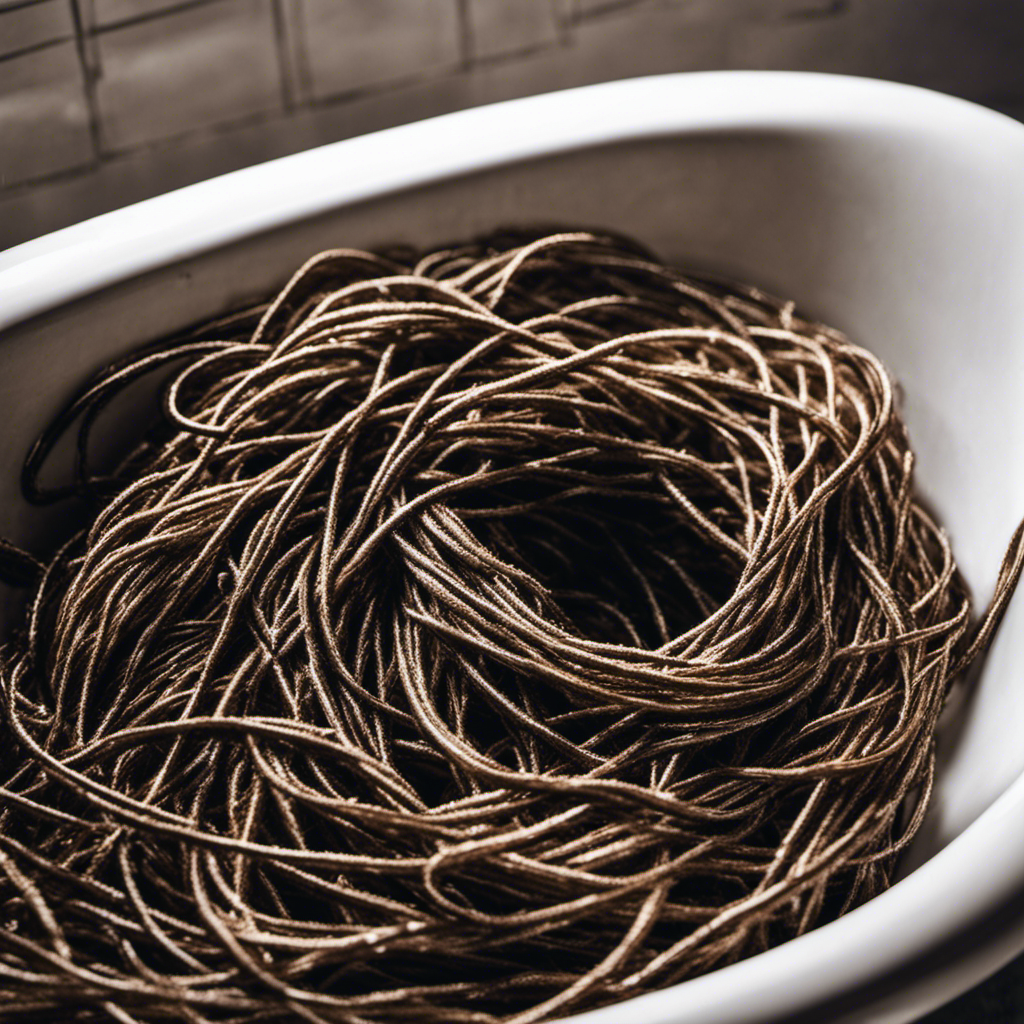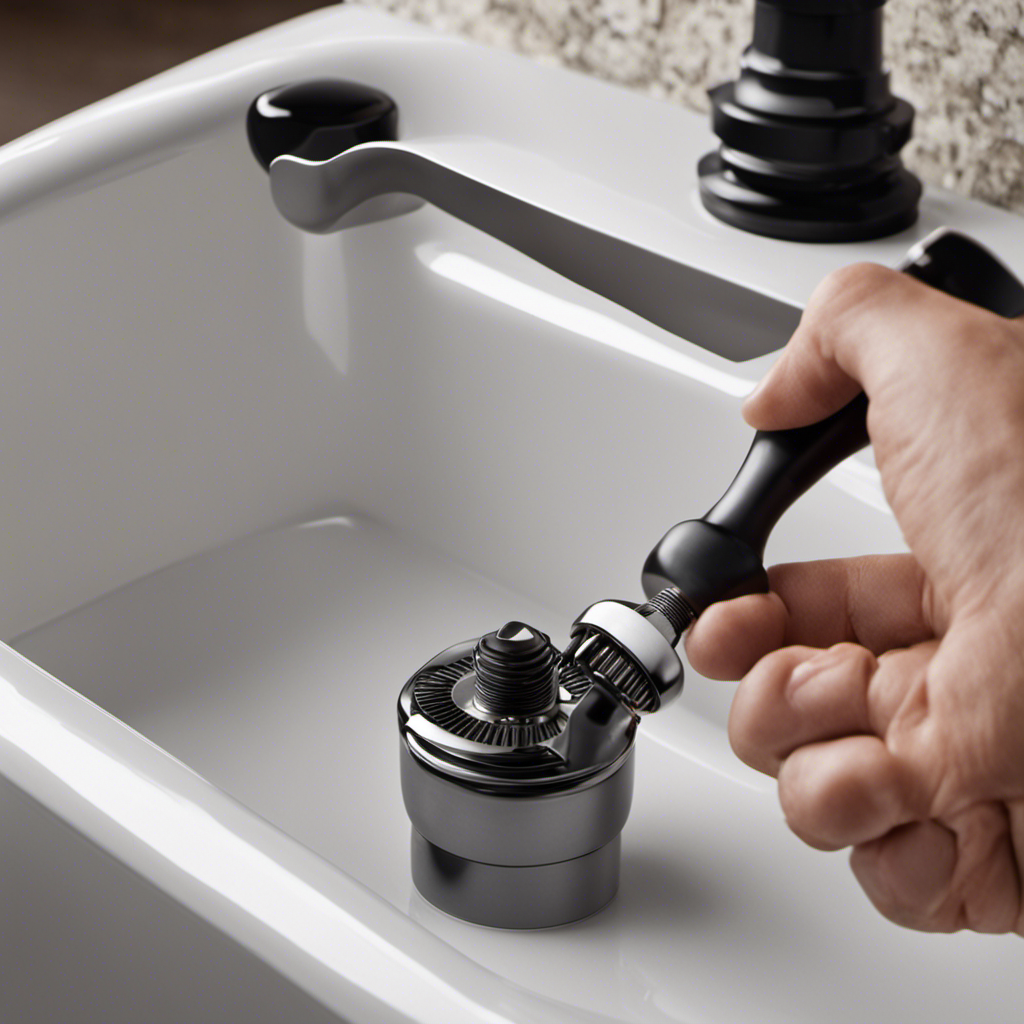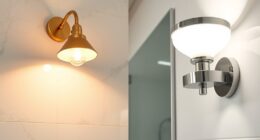Are you tired of dealing with a clogged bathtub drain that’s filled with hair? Imagine finally being able to take a relaxing bath without worrying about standing in a pool of water.
In this article, you’ll learn how to unclog your bathtub drain using simple and effective methods. From identifying the cause of the clog to preventing future hair blockages, we’ve got you covered.
Get ready to say goodbye to those pesky hair clogs once and for all.
Key Takeaways
- Soap scum buildup can lead to clogs, so regular cleaning and using a strainer can prevent clogs.
- Harsh chemical drain cleaners can damage pipes, so consider using natural drain cleaners like baking soda and vinegar.
- Removing hair from the drain opening with gloves and pliers can prevent future clogs, and using a wire hanger or drain snake may be necessary for stubborn clogs.
- To clear a clog, a plunger can create suction to dislodge it, and covering overflow openings maximizes suction. Natural alternatives like baking soda and vinegar can also be used.
Identifying the Cause of the Clog
Now, you’re going to want to take a look at what might be causing the clog in your bathtub drain. One common culprit is soap scum buildup. Soap residue can accumulate in the drain over time, leading to a clog. To prevent this, make sure to clean your bathtub regularly and use a strainer to catch any excess soap or hair.
Another cause of clogs can be the use of harsh chemical drain cleaners. These can actually damage the pipes and cause more problems in the long run. Instead, opt for natural drain cleaners like baking soda and vinegar. They are effective in breaking down clogs and are safe for your pipes.
By preventing soap scum buildup and using natural drain cleaners, you can help keep your bathtub drain free from clogs.
Now, let’s move on to the next step: removing hair from the drain opening.
Removing Hair From the Drain Opening
To start, you’ll need a pair of gloves and a small pair of pliers to remove any debris from the drain opening.
Follow these steps to effectively remove hair from your bathtub drain:
-
Put on the gloves to protect your hands from any potential bacteria or sharp objects in the drain.
-
Use the pliers to carefully remove any visible hair or debris that may be clogging the drain. Be gentle to avoid damaging the pipes.
-
If you encounter resistance, try using a wire hanger or a drain snake to break up and remove the blockage.
-
Once you have cleared the hair from the drain opening, consider using natural drain cleaners to prevent future clogs. These can include a mixture of baking soda and vinegar, or enzyme-based cleaners that break down organic matter.
Using a Plunger to Clear the Clog
Using a plunger can effectively clear the clog in your bathtub. Plungers work by creating suction, which helps dislodge the blockage and restore the flow of water.
To use a plunger, place the rubber cup over the drain opening, ensuring a tight seal. Push down firmly and then pull up quickly, repeating this motion several times. This technique helps to create pressure changes that can dislodge the clog. Remember to cover any overflow openings to ensure maximum suction.
There are variations in plunger techniques, such as using a plunger with a flange for toilets or using a smaller plunger for sink drains.
If you prefer a natural approach, you can try DIY drain cleaners like a mixture of baking soda and vinegar or a combination of salt, baking soda, and hot water. These natural cleaners can help break down the clog and clear the drain effectively.
Using a Drain Snake or Zip-It Tool
If you’re looking for an alternative method, try using a drain snake or a Zip-It tool to clear the clog in your bathtub. These tools are specifically designed to tackle hair clogs and can be highly effective in removing them.
Here are four key points to keep in mind when using these alternative tools:
-
Drain Snake: This flexible tool consists of a long, coiled wire with a hook at one end. Insert the snake into the drain and rotate it to catch the hair. Slowly pull it out, along with the clog.
-
Zip-It Tool: This plastic tool features barbs along its length to grab onto hair and debris. Insert the tool into the drain and pull it out in a steady motion, removing the clog along the way.
-
After unclogging the drain, dispose of the hair properly. Place it in a plastic bag and seal it tightly to prevent any odors. Dispose of the bag in your regular trash.
-
Remember to clean and sanitize your tools after use to prevent the spread of bacteria.
Preventing Future Hair Clogs
To prevent future clogs, make sure to regularly clean and maintain your bathtub drains. Hair loss can be a common cause of clogged drains, so taking steps to prevent hair from going down the drain is essential. Incorporating natural remedies for hair growth can also help reduce hair loss and minimize the amount of hair that ends up in your drains. In addition to using a drain catcher to catch hair before it goes down the drain, consider incorporating these natural remedies into your hair care routine:
| Natural Remedies for Hair Growth |
|---|
| Massage your scalp with essential oils like rosemary or lavender |
| Use a natural hair mask made from ingredients like coconut oil or aloe vera |
| Eat a balanced diet rich in vitamins and minerals that promote hair health |
Frequently Asked Questions
What Are Some Alternative Methods to Remove Hair From the Drain Opening if I Don’t Have a Drain Snake or Zip-It Tool?
You can use home remedies or natural solutions to remove hair from the drain opening if you don’t have a drain snake or zip-it tool. These methods are effective and don’t require any special tools.
Is It Safe to Use Chemical Drain Cleaners to Unclog a Bathtub Drain?
Using chemical drain cleaners to unclog a bathtub drain can be effective, but it comes with pros and cons. It’s important to follow safety precautions, such as wearing gloves and goggles, to prevent any harm.
How Often Should I Clean My Bathtub Drain to Prevent Hair Clogs?
To prevent hair clogs in your bathtub drain, it’s important to clean it regularly. Signs of a clogged drain include slow draining, water backing up, and unpleasant odors. Clean it every month or as needed.
Can I Use a Plunger to Clear a Clog in a Bathtub That Has a Built-In Stopper?
To unclog a bathtub drain without any tools, try using a plunger with a built-in stopper. By creating a strong suction, the plunger can help dislodge and remove the clog, allowing water to flow freely again.
What Should I Do if None of the Methods Mentioned in the Article Work to Unclog My Bathtub Drain?
If the methods in the article don’t work to unclog your bathtub drain, try alternative solutions like using a drain snake or baking soda and vinegar. If all else fails, consider calling a professional for assistance.
Conclusion
Congratulations! You’ve successfully learned how to unclog your bathtub drain from hair. By following these simple steps, you’ve taken control of your plumbing woes.
Now imagine the satisfaction of watching the water flow freely down the drain, like a rushing river on a warm summer day. No more standing in a pool of dirty water, no more frustration.
With your newfound knowledge, you can confidently tackle any hair clog that comes your way. Remember to stay proactive in preventing future clogs and enjoy your clean and clear bathtub.
Happy unclogging!










